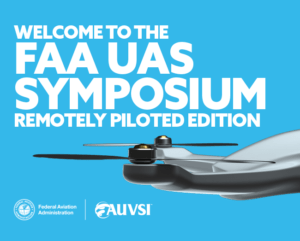Last week’s virtual FAA UAS Symposium, a joint event sponsored by AUVSI and the FAA, featured a wide range of speakers from the regulatory and drone communities. In “Perspectives from Capitol Hill”, Rep. Rick Larsen, Chair of the House Aviation Sub Committee, explained how law makers approach the complex issues of drone integration into the NAS.
Rep. Larsen emphasized that “safe and efficient integration of drones into the U.S. airspace” was a top priority for Congress, commenting that government research predicts that the fleet of small hobbyist drones in the U.S. will grow by more than 1,000,000 units, while the commercial drone fleet will double to more than 800,000. “…The U.S. aerospace economy cannot risk domestic companies going abroad… if the regulatory framework is not in place,” said Larsen.
That’s the theme that carried throughout Larsen’s comments: lawmakers and regulatory authorities must move quickly in order to ensure that the regulatory framework in the U.S. supports growth and innvoation in the drone industry.
Larsen praised the publication of “two long awaited UAS rules” – Remote ID and Operations Over People – saying that advanced drone use could only be possible with reliable Remote ID systems in place. Rep. Larsen also cited the BEYOND program as a means of addressing the remaining problems of drone integration.
Larsen said, however, that the FAA must leverage the progress made to enable more complex drone operations, and must “move swiftly” on unmanned traffic management (UTM) implementation and testing. Congress, Larsen stated, will maintain a “forward-looking agenda to ensure that the U.S. remains a global leader – to ensure that we continue to push forward on drone integration.”
“We’re a Long Way from Drone Integration.”
Jay Merkle (FAA) and Brian Wynne (AUVSI), commenting on Rep. Larsen’s speech, agreed with his statement that the U.S. has a long way to go before fully integrating drones into the airspace. Merkle said that the FAA is working towards performance-based, tech agnostic rules that encourage innovation. The FAA’s approach is based around the question of “what’s possible,” Merkle said, and they are continuing to work on how to allow “increasingly more complex operations.”
AUVSI President Brian Wynne said that the drone industry has a large role to play in helping regulators move forward. “….One of the biggest barriers is public acceptance,” Wynne commented, saying that the industry needed to continue to develop applications that bring real value to the public. “We’ve [the drone industry] got to be bringing something to the community….Those are the people that Congressmen Larsen and his colleagues up on the hill spend the most time thinking about. ”

Miriam McNabb is the Editor-in-Chief of DRONELIFE and CEO of JobForDrones, a professional drone services marketplace, and a fascinated observer of the emerging drone industry and the regulatory environment for drones. Miriam has penned over 3,000 articles focused on the commercial drone space and is an international speaker and recognized figure in the industry. Miriam has a degree from the University of Chicago and over 20 years of experience in high tech sales and marketing for new technologies.
For drone industry consulting or writing, Email Miriam.
TWITTER:@spaldingbarker
Subscribe to DroneLife here.
